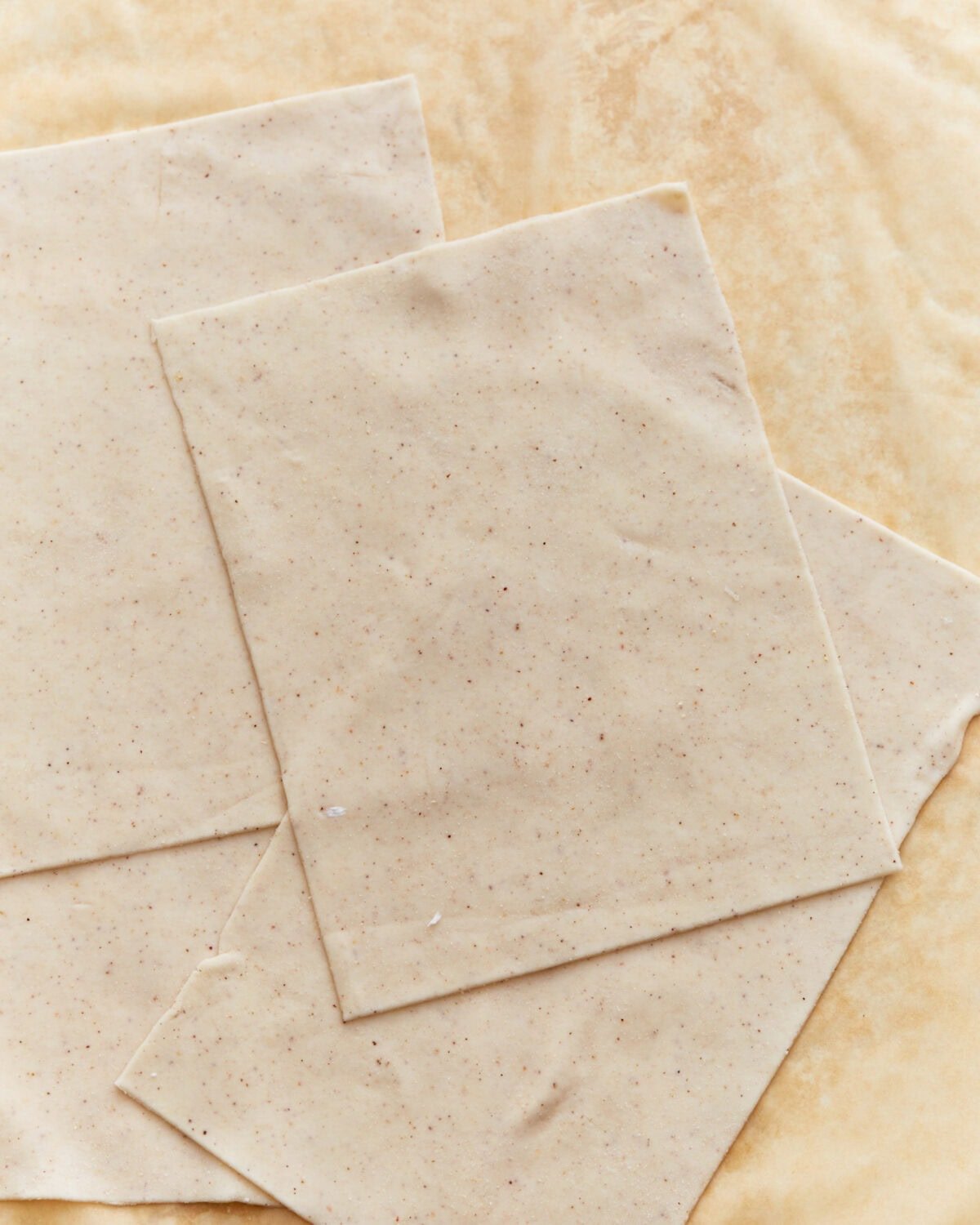This post may contain affiliate links. To learn more check my disclosure page.
It’s easier to make homemade gluten-free phyllo dough than you think! I’ve tested this recipe many times now, and it always creates a perfectly flaky, delicious filo pastry that can be used for sweet and savory dishes. I use xanthan gum to replace the missing gluten, which forms an elastic dough that can be easily rolled into paper-thin sheets. You don’t even need a stand mixer, pasta machine, or any other fancy equipment to make it!

Gluten-Free Phyllo Dough Recipe
Phyllo dough, or filo pastry, is a popular ingredient in Balkan, Greek, and Middle Eastern cuisines. It’s a thin pastry dough (traditionally made with wheat flour) that can be layered to create a delicious, flaky texture and is a staple for dishes such as baklava and spanakopita.
I’ve been working hard on recreating my favorite bakery treats without gluten (have you tried my gluten-free croissant recipe yet?), and I knew gluten-free phyllo dough was next on the list. I mix all-purpose gluten-free flour, xanthan gum, melted butter, and cornstarch to create a flexible dough that crisps up nicely in the oven. You’ll need a little time and patience to roll the dough out thin enough, but once you get the hang of it, you’ll never look back!
Ingredients
- All-Purpose Gluten-Free Flour: Use a high-quality gluten-free flour that is a 1-to-1 substitute for regular wheat flour. We like Pillsbury gluten-free and Better Batter Cup for Cup. Not all gluten-free flour blends are created equal. You may experience different results depending on what brand you use.
- Xanthan Gum: Without this ingredient, our gluten-free phyllo dough would be a crumbly mess. It helps to bind the dough together and create an elastic texture. You still need to add xanthan gum even if your flour includes it—just reduce the amount from 2 teaspoons to 1 teaspoon in that case.
- Cornstarch: Adds even more elasticity to the dough for easier rolling.
- Sugar: Helps the dough to crisp up and turn golden brown when baked. Don’t worry; it only adds a subtle sweetness, and the pastry can still be used for savory recipes.
- Salt: For seasoning the dough.
- Lukewarm Water: This hydrates the flour quicker than cold water would and makes the dough more pliable.
- Unsalted Butter: Creates a tender yet crisp filo pastry.

Tips and Suggestions
- I recommend using kitchen scales to weigh each portion of dough to make sure they’re all the same size for even layers.
- Make sure you lightly flour your work surface to stop the dough from sticking.
- A thin rolling pin (like a dowel) with tapered ends is best for delicate dough like phyllo. They’re easier to control and require less pressure, which avoids us tearing the dough. But a regular rolling pin will do just fine if you don’t have one!
- If possible, roll the dough from the center outward to create an even thickness. Do this all the way around the dough to avoid any thin spots that may cause tearing.
- The thinner the dough gets, the more delicate it becomes. We want to roll it thinly without it breaking (I aim for about 1/8 inch thick). Avoid pressing down too hard on the rolling pin; use a gentle rolling motion to help the dough spread out.
- Cover the dough sheets with a damp kitchen towel or plastic wrap to stop them from drying out. Work with a few sheets at a time and keep the remaining sheets covered.
- Any sheets with holes/tears can be layered together and used as the bottom or middle layers in your chosen recipe.
Is Phyllo Dough the Same as Puff Pastry?
No, phyllo dough and puff pastry aren’t the same. While they both create flaky, layered pastries, the main difference is how they’re made. Phyllo is made by rolling out paper-thin sheets of dough, which are then stacked on top of each other. Puff pastry is made from a ‘laminated’ dough, which involves layering butter between sheets of dough and then folding and rolling it out multiple times to create distinct flaky layers. They can sometimes be used interchangeably, but the result will be slightly different.

What Can I Make with Gluten-Free Phyllo Dough?
I like to make a gluten-free spanakopita, a traditional Greek pie made with spinach and feta cheese. It’s really simple to make once you have your dough ready! Some other ideas include:
- Baklava (a sweet pastry made with nuts and honey)
- Gluten-free baked brie
- Savory vegetable tarts
- As a gluten-free pie crust alternative for gluten-free chicken pot pie or other savory pies
- Apple turnovers or strudel
- Mini gluten-free quiches (cut the sheets into quarters and line a muffin tin)
When you’re ready to bake with your dough, I suggest brushing each sheet with melted butter or oil before layering to stop sticking and to create that signature flakiness.
Can I Freeze the Dough?
Yes, you can freeze gluten-free phyllo dough for 2-3 months. Stack the sheets with parchment paper or plastic wrap in between to prevent sticking. Roll up the stack tightly and cover with plastic wrap, or place it in an sealed container. Let the dough thaw in the refrigerator before using.
Short-Term Storage Instructions
If you’re not using your dough right away, you can store it in the refrigerator for up to 3 days. Just make sure to wrap it tightly in plastic wrap to stop it from drying out.

More From Scratch Gluten-Free Recipes to Try!
- Gluten-Free Egg Noodles
- Gluten-Free Roux
- Homemade Gluten-Free Pasta
- Gluten-Free Tempura Batter
- Gluten-Free Ravioli
Gluten-Free Phyllo Dough / Filo Pastry

Ingredients
- 2 cups gluten-free all-purpose flour
- 2 teaspoons xanthan gum, reduce to 1 teaspoon if your blend already contains it
- ¼ cup cornstarch
- 2 teaspoons sugar
- 1 teaspoon salt
- ¾ cup lukewarm water
- 2 tablespoons unsalted butter, melted
Instructions
- In a large bowl, whisk together the gluten-free flour, xanthan gum, cornstarch, sugar, and salt until well combined.
- Create a well in the center of the dry ingredients and pour in the lukewarm water and melted butter. Using a sturdy spoon or your hands, gradually incorporate the dry ingredients into the wet ingredients until a shaggy dough forms.
- Turn the dough onto a lightly floured surface and knead for about 5 minutes until smooth and pliable. If the dough seems too sticky, add a little more gluten-free flour, 1 tablespoon at a time.
- Cover the dough with plastic wrap or a damp towel and let it rest at room temperature for 30 minutes.
- After resting, divide the dough into 4 equal portions. On a lightly floured surface or parchment paper, roll out each portion into a rectangular shape, about 1/8 inch thick.
- Using a sharp knife or a pizza cutter, cut the dough into rectangles, approximately 10×8-inch. Cut into smaller rectangles as desired. Cover them with a damp towel or plastic wrap to prevent drying out.
- Use the gluten-free phyllo dough sheets immediately or store them in an airtight container in the refrigerator for up to 3 days.
Notes
- If possible, use a thin rolling pin when rolling out the dough, and don’t apply too much pressure. Gently roll the dough from the center outwards in each direction.
- Cover the dough with a damp kitchen towel when not using to keep it from drying out.
- To Store: Wrap in plastic wrap and refrigerate for up to 3 days.
- To Freeze: Layer parchment paper or plastic wrap between each sheet and roll tightly before wrapping in plastic. Freeze for up to 3 months.
- Mama says, “Check all of your labels!”
Nutrition
Nutrition information is automatically calculated, so should only be used as an approximation.
How to Make Gluten-Free Phyllo Dough – Step-by-Step

In a large bowl, whisk together 2 cups gluten-free all-purpose flour, 2 teaspoons xanthan gum (reduce to 1 teaspoon if your blend already contains it), ¼ cup cornstarch, 2 teaspoons sugar, and 1 teaspoon salt until well combined.

Create a well in the center of the dry ingredients and pour in ¾ cup lukewarm water and 2 tablespoons melted butter. Using a sturdy spoon or your hands, gradually incorporate the dry ingredients into the wet ingredients until a shaggy dough forms.

Turn the dough onto a lightly floured surface and knead for about 5 minutes until smooth and pliable. If the dough seems too sticky, add a little more gluten-free flour, 1 tablespoon at a time.

Cover the dough with plastic wrap or a damp towel and let it rest at room temperature for 30 minutes.

After resting, divide the dough into 4 equal portions. On a lightly floured surface or parchment paper, roll out each portion into a rectangular shape, about 1/8 inch thick.

Using a sharp knife or a pizza cutter, cut the dough into rectangles, approximately 10×8-inch. Cut into smaller rectangles as desired. Cover them with a damp towel or plastic wrap to prevent drying out.

Use the gluten-free phyllo dough sheets immediately or store them in a sealed container in the refrigerator for up to 3 days.












